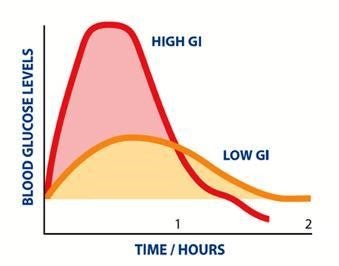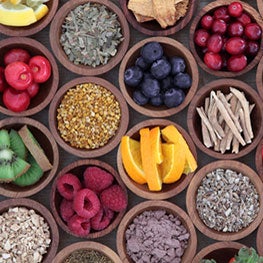What Is Low GI? The Glycemic Index Explained

A low GI diet is thought to be a healthy and sustainable diet for keeping your weight and blood glucose levels in check, as well as supporting your overall health. But exactly what is low GI?
Whether you’ve never heard of the term ‘glycaemic index’ (GI) before or you want to know more about low GI diets, we’ve got your back. Here we take a closer look at the glycaemic index, how it works, low GI diets, and ask — what is low GI?
What is the glycemic index?
If you want to know what low GI really is, you first need to ask — what is the glycaemic index?
The term ‘GI’ refers to the Glycaemic Index — a ranking system that measures how carbohydrates affect blood glucose (blood sugar) levels.
Carbohydrates are an essential part of a healthy diet. They are a macronutrient, which means that our body needs them in relatively large quantities (compared to other nutrients, like vitamins and minerals) in order to function. Carbohydrates are our main source of energy, fuelling everything from our heart to our brain and central nervous system.
Carbohydrates (or carbs) are found in bread, pasta, cereal, fruit and vegetables and dairy products. When we eat these foods, our body takes the carbohydrates in them and breaks them down into sugars that enter the bloodstream, causing blood glucose levels to rise.
All carbohydrate-containing foods have an impact on blood glucose levels. The glycaemic index is used to measure the effect of carbohydrate-containing foods on blood glucose levels after consumption.
What is low GI?
As we’ve mentioned above, the impact that a carbohydrate-containing food has on blood glucose levels can be measured using the GI value.
A carbohydrate-containing food is given a rating out of 100 and is compared to the absorption of 50g of pure glucose.
A glycemic index of
- 55 or less is considered low GI
- 56 to 69 is considered medium GI
- 70 or more is considered high GI
A low GI is a value of 55 or less. Foods that have a low GI are considered beneficial for our health by helping to control blood glucose levels after eating. They can also make us feel fuller for longer, which may help to avoid over-eating.
Low GI vs high GI
So now you know that the glycaemic index is divided into three categories and ratings. But what is the real difference between low GI and high GI?
Low GI foods produce a slower, lower rise in blood glucose levels. High GI foods produce a faster, higher rise in blood glucose levels, which then also decrease much faster.

Image credit: glnc.org.au
In the short term, blood glucose spikes can lead to lethargy, low mood and hunger. In addition, consuming a high GI diet can impact the body’s ability to control blood glucose levels. This can be particularly important for those who have type 2 diabetes.
Low GI carbohydrates are digested and absorbed slowly. This more gradual release of glucose into the bloodstream is thought to be more beneficial to us. The steady release of glucose helps to sustain energy levels and stave off hunger (as well as a range of other benefits).
The benefits of low GI diets
Following a low GI diet is thought to have a number of health benefits.
- Help you feel fuller for longer
- Provide longer-lasting energy
- Provide sustained energy levels to the brain, which improves concentration and cognitive function
In particular, low GI foods can have health benefits for those with diabetes and people looking to lose weight.
Low GI foods
There are GI search tools available online that can help you determine the glycaemic index of a wide range of foods.
In the meantime, here is an overview of some of the low GI foods:
- Wholegrain bread and cereals
- Basmati rice
- Wholemeal pasta
- Sweet potato
- Corn
- Peas
- Legumes
- Apples and pears
- Milk and yoghurt
There are plenty of healthy, nutritious foods out there that you can build into a low GI diet. Be aware that not all foods that are low GI are necessarily healthy — foods high in fat often have a low GI (e.g. chocolate or corn chips) and should only be included occasionally.
GI values are variable depending on a number of factors such as: the product recipe, manufacturing process, growing conditions in the country of origin and whether the product is fresh or preserved. Using online GI search tools can help you to find the GI values of specific products.
High GI foods
Foods with a high GI should be limited.
Here are some high GI foods you should try to avoid eating or limit your intake of:
Soft white breads
Refined commercial processed cereals such as corn flakes and rice cereals
Jasmine or medium grain rice
Water crackers, rice crackers and crispbreads
Cordials and soft drinks
White potatoes (except low GI varieties)
Watermelon
Puffed corn and rice
Confectionery
There isn’t a clear set GI value that can be given to these foods — GI values can vary depending on factors such as the product itself, the manufacturing process and country it comes from. In some cases, there may be alternatives within a product category that have low GI. Using an online GI search tool can help you to find the value for the specific product you’re looking for.
Reducing your intake of these high GI foods can help control blood glucose levels and manage weight and general health.
Low GI diet plan
Are you thinking of switching out your high GI carbohydrate foods for some low GI alternatives?
Planning out what you are going to eat for meals and snacks can help you to easily transition to a low GI diet. Just doing this a week at a time can make a big difference and ensure that you keep your intake of high GI foods to a minimum.
To get you started, here is an example of what a healthy low GI diet plan would look like for one day:
Day 1
- Breakfast: porridge made with rolled oats and water, and low GI fruit (e.g. apple) or a smoothie for breakfast using SUSTAGEN Hospital Formula with berries, spinach and milk
- Snack: carrot sticks and hummus and a shake (made with water)
- Lunch: vegetable soup served with a slice of whole-grain bread
- Snack: edamame beans
- Dinner: lentil dahl served with vegetables
It is important to remember that a healthy balanced diet should include foods from all food groups at all meals and snacks. This includes low GI wholegrain breads and cereals, fruits and vegetables, dairy and meat and meat alternatives.
SUSTAGEN Hospital Formula is a formulated meal replacement and cannot be used as a total diet replacement. Consume as part of a varied and balanced diet and healthy lifestyle.
Sources
- https://www.gisymbol.com/low-gi-explained/
- https://glycemicindex.com/gi-search/
- https://www.mayoclinic.org/healthy-lifestyle/nutrition-and-healthy-eating/in-depth/glycemic-index-diet/art-20048478
- https://care.diabetesjournals.org/content/31/12/2281.figures-only




